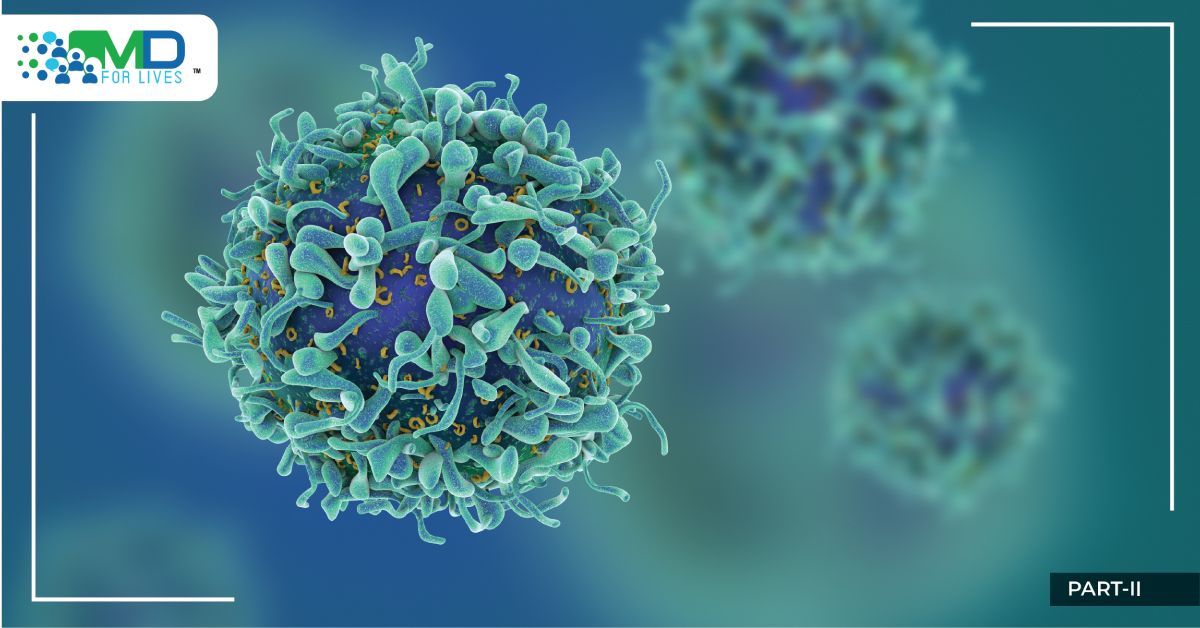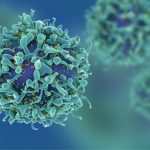RET
RET (an abbreviation for Rearranged during Transfection) encodes a receptor tyrosine kinase for members of the glial cell line-derived neurotrophic factor (GDNF) family of extracellular signaling molecules. The human gene RET is localized to chromosome 10 (10q11.2), contains 21 exons, and is fused to an upstream gene partner (commonly KIF5B). This fusion results in ligand-independent dimerization and downstream growth pathway activation. It is oncogenic in vitro and in vivo.
RET is mostly seen in young, never smoked, or former light cigarette smokers and is seen in approximately 2% of lung adenocarcinoma, with its most common features being its solid subtype and signet ring cells. It is diagnosed by FISH or NGS.
The drug cabozantinib (a small molecule inhibitor of the tyrosine kinases c-Met and VEGFR2, which also inhibits AXL) was shown to have a good response in patients with RET-rearranged lung adenocarcinomas, with 38% ORR, mPFS of 7 months and OS of 10 months.
In a US phase 2 study of cabozantinib (Study no: NCT01639508, 2012-2016), of the 25 metastatic or unresectable lung cancer patients harboring a RET rearrangement (Karnofsky score >70 and measurable disease), ORR was 28%, with the most common grade 3 treatment-related adverse event being lipase elevation in 15% of the cohort, increased alanine aminotransferase in 8%, increased aspartate aminotransferase in 8%, decreased platelet count in 8%, and hypophosphatemia in 8%. No drug-related deaths were recorded, but 16% died during follow-up.
Other drugs that have shown response in RET include vandetanib (an antineoplastic kinase inhibitor) and sunitnib (a small-molecule, multi-targeted receptor tyrosine kinase inhibitor that was approved by the FDA for the treatment of renal cell carcinoma and imatinib-resistant gastrointestinal stromal tumor).
In 2015, a 63-year-old Asian woman was diagnosed with metastatic lung adenocarcinoma, with lung, bone, and brain metastases. She had taken erlotinib but progressed after 1 month. She then received cisplatin + pemetrexed with docetaxel chemotherapy, but a newly onset malignant pleural effusion developed. A genetic study found that she had a KIF5B-RET fusion gene but not a mutant epidermal growth factor receptor (EGFR) gene. The patient suffered from respiratory failure, and a CXR suggested that she had consolidation in both lung fields. After being treated with sunitinib (37.5mg per day), her respiratory distress improved after day 3, and oxygenation improved as well. A CXR on day 9 suggested a resolution of lung haziness.
However, grade 3 fatigue and thrombocytopenia, as well as grade 2 leukopenia and neutropenia, developed after 10 weeks of sunitinib, and 3 days after she discontinued, dyspnea developed, with multiple consolidations over bilateral lungs and the patient soon passed away.
NTRK1 oncogene
NTRK, or neurotrophic tyrosine receptor kinase, was originally identified as OncD. TRK encodes the TPM3–NTRK1 gene fusion and was one of the first transforming chromosomal rearrangements identified in colon cancers in 1982. Since then, NTRK1 has been identified in multiple tumor types in recent years, including glioblastoma, cholangiocarcinoma, pancreatic cancer, low-grade gliomas, etc., while gene fusions involving the highly homologous NTRK2 and NTRK3 genes have been identified in 11 different tumor types.
Below is an image showing NTRK fusions:
In lung cancer, there are 3 NTRK fusion models, with an incidence approaching 1%. There is no limitation with age; it seems to be independent of gender or smoking habit, and it is also present in different histological subtypes.
In terms of treatments, there are several TRK inhibitors under development.
One of these drugs is MGCD516, now known as sitravatinib. Sitravatinib is an oral spectrum-selective kinase inhibitor. It potently inhibits receptor tyrosine kinases (RTKs), including
TAM family receptors (TYRO3, AXL, MERTK)
Split family receptors (VEGFR2, KIT)
By targeting specific RTK receptors with sitravatinib, the immunosuppressive tumor microenvironment (TME) is converted to an immune-supportive TME. This way, cancers are more likely to respond to checkpoint inhibitor treatment
In 2019, the Phase 3 SAPPHIRE trial began, comparing the efficacy of sitravatinib in combination with the PD-1 inhibitor nivolumab vs docetaxel in patients with advanced non-squamous NSCLC who have previously experienced disease progression on or after platinum-based chemotherapy and checkpoint inhibitor therapy. The inclusion criteria are shown below:
The study is still continuing, but preliminary results showed that twenty-one (84%) out of 25 patients experienced tumor reductions and 7 (28%) patients a partial response. The phase 2 results below informed the SAPPHIRE trial:
The LMNA-NTRK1 fusion has also shown activity in lung cancer. In the images below, LOXO-101, now known as larotrectinib, exhibits an excellent and durable response.
In the phase 2 trial: NCT02576431 (2015), larotrectinib was assessed in 14 patients with NTRK gene fusion positive advanced lung cancer, 8 of which had CNS metastases. For the patients with CNS metastases at baseline, the ORR was 71%, with no CRs, 5 PRs, and 2 patients with the stable disease by IRC. Also with the CNS patients, the mPFS, OS, and DoR were 9.9 months, 17.2 months, and 9.5 months, respectively. The estimated PFS rate at 12 months was 61% and the estimated OS rate at 12 months was 91%. . Treatment-emergent adverse events were mostly graded 1/2, with the most common being myalgia, cough, and dizziness. Six patients experienced grade 3 AEs and 2 had grade 3 treatment-related AEs. No grade 4/5 toxicities were observed in these patients. No patients permanently discontinued treatment due to AEs.
In 2019, the FDA approved Entrectinib, a selective tyrosine kinase inhibitor of the tropomyosin receptor kinases A, B, and C, C-ros oncogene 1, and anaplastic lymphoma kinase.
In an integrated analysis of 3 trials: ALKA-372-001 (2012-2018), STARTRK-1 (2014-2018), and STARTRK-2 (2015- present day) (enrolment ongoing), assessing the effect of entrectinib in NSCLC: 41 of 53 patients in the efficacy-evaluable population had an objective response. Median follow-up was 15·5 months. Median DoR was 24.6 months. In the safety-evaluable population, 79 of 134 patients had grade 1 or 2 treatment-related adverse events. Out of 134 patients, 46 had grade 3 or 4 treatment-related adverse events, with the most common being weight increase (10) and neutropenia (5). Fifteen patients had serious treatment-related adverse events, the most common of which were nervous system disorders (4) and cardiac disorders (3). No treatment-related deaths occurred.
In a study of one patient published by Farago, in the Journal of thoracic oncology, 2015, the type of fusion, the FISH analysis, and the durable clinical response to entrectinib in NTRK1-rearranged NSCLC were shown.
The patient also showed a complete response of brain metastases to entrectinib. You can see below the baseline head CT scan at day-7 demonstrating metastases (green arrows) in the right thalamus (A), left occipital lobe (B), and left cerebellum (C). While D-F shows the restaging head CT scans at day 26 and G-I shows day 155 on entrectinib.






